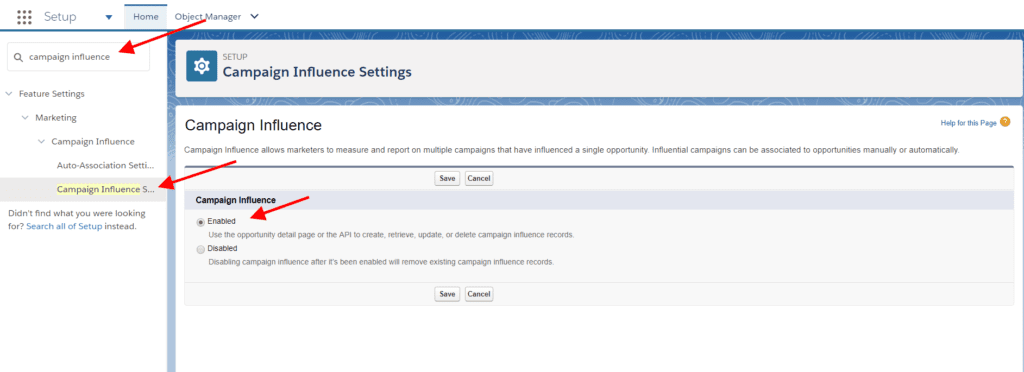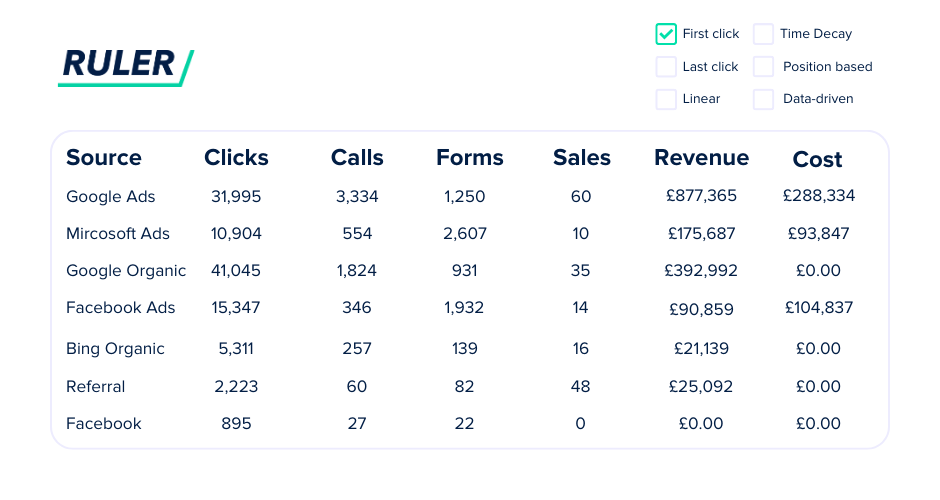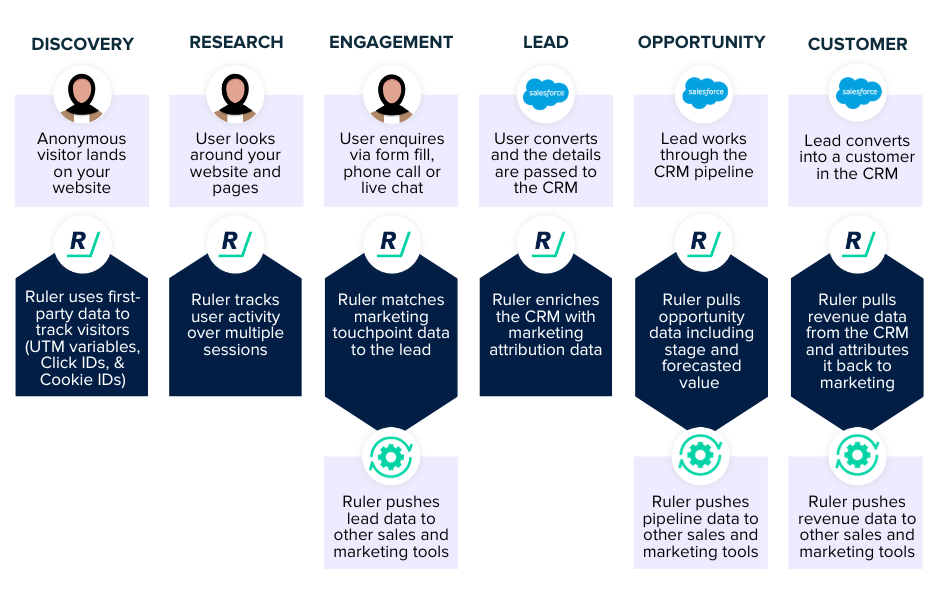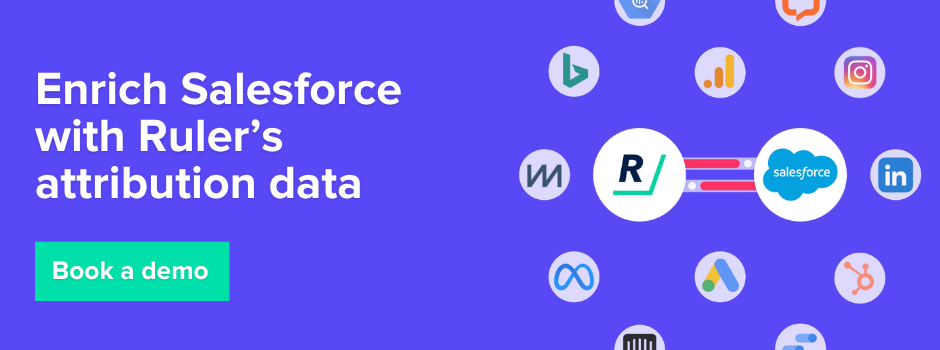Salesforce Campaign Influence allows you to effectively track the impact of your marketing campaigns on revenue, but is there an easier way?
Marketers need to demonstrate their value to the business, even more now than ever before.
To do this, marketers need to know exactly how their strategies impact the opportunity and sales pipeline.
However, for too long, marketers have relied on vanity metrics such as lead volume, page views, and site traffic as the primary measure of success.
While vanity metrics often look good on the surface, underneath the hype, they’re empty.
They tell you nothing about the role marketing plays in growing and maintaining revenue within the business.
Fortunately, for Salesforce users, they have access to campaign Influence. This feature allows marketing and sales teams to track which campaigns lead to the most valuable sales opportunities and revenue.
While campaign influence has many ways to visualise your impact on opportunities, it comes with some big question marks: Is it reliable enough to measure the effectiveness of your marketing campaigns?
Let’s find out.
In this article, we’ll discuss:
💡 TL;DR
Salesforce Campaign Influence is a popular feature that connects marketing campaigns to opportunity revenue, but it has room for improvement.
A fundamental limitation of Salesforce Campaign Influence is that it only tracks leads after they are created. In other words, you can’t see how your marketing campaigns are influencing leads before they’re converted.
Ruler lets you track customer journeys at the individual visitor level and matches anonymous visitors to their marketing touchpoints. It enriches Salesforce leads and opportunities with attribution data, so you can see exactly how marketing affects pipeline generation. Book a demo and learn more about how Ruler can help you track the full customer journey.
For those of you that don’t know, Campaign Influence in Salesforce is an out-of-the-box feature that allows you to leverage CRM data and connect the dots between opportunity revenue and campaign data.
It allows you to identify how many opportunities a campaign has influenced and reveals which marketing tactics are most effective in driving revenue.
To enable Salesforce Campaign Influence, all you need to do is follow these steps.
Important note: For Pardot users, you’ll need to turn on Connected Campaigns first. This will allow you to report on Pardot campaigns within Salesforce.

Once Campaign Influence is enabled, you can optimise your reports to show how marketing activities are contributing towards the sales pipeline and closed revenue.
When you start with Campaign Influence in Salesforce, you’ll have the option to choose between Campaign Influence 1.0 and Custom Campaign Influence.
At first glance, Campaign Influence 1.0 and Custom Campaign Influence share a lot of similarities, but they do have a few differences.
The purpose of Campaign Influence 1.0 is to help marketers understand the return of their campaign investments. To achieve this, Campaign Influence 1.0 awards 100% of the credit to the first campaign that is associated with an opportunity.
For example, let’s say John is an opportunity in your Salesforce CRM.
John’s first known interaction is when he downloads an eBook after receiving an outreach email from your marketing team.
In this event, the outreach campaign would receive 100% of the credit for this opportunity.
Customisable Campaign Influence is essentially the same as campaign influence 1.0, but it offers a few more capabilities not currently available in the standard version.
One stand out difference is that Customisable Campaign Influence lets you understand how multiple campaigns work together to deliver opportunities and revenue in Salesforce.
Unlike the standard version, Customisable Campaign Influence allows you to measure the impact of your campaigns using three different attribution models.
Campaign influence in Salesforce has made it possible for marketers to assign credit to the campaigns that drive opportunities and revenue, but it isn’t perfect.
Campaign Influence is a “built-in feature”.
In other words, the customer journey in Salesforce only starts once a lead has been created.
Let’s say you send out an email campaign with a link to download your eBook.
Someone clicks the link and converts it into a lead. In Salesforce, this would be considered as the first touchpoint.
But how did this lead end up on your mailing list?
Had they previously visited your website via a Google Paid ad and subscribed to your newsletter? Maybe they found you via organic search.
Using Campaign Influence alone, you’d never know.
This is where tools like Ruler come in handy.
Ruler tracks the influence of different marketing touchpoints across the customer journey, from initial awareness to close.

This allows you to understand which marketing channels are most effective in Salesforce and to optimise your marketing campaigns for maximum results.
You can learn more about Ruler later in this article, or download our eBook to learn how Ruler enriches Salesforce with attribution data.
While campaign performance data is readily available in Salesforce, Campaign Influence doesn’t provide much insight into marketing source data, and as marketers, we want to know the following:
1. WHERE our leads are coming from i.e. social paid, organic search.
2. HOW our leads are converted i.e. eBook download, demo. e.g. phone call, demo, etc.
Related: How to track marketing lead source data in Salesforce
Although, more importantly, we want to see how our efforts influence the pipeline and revenue outcomes.
Combining Salesforce activity with marketing source data provides you with a better understanding of your customer journey and can help you prioritise marketing spend in the right areas.
Unfortunately, Salesforce was geared towards sales teams, and is not designed for marketers.
So, it doesn’t hold the data you need to connect your marketing campaign with sales and revenue activity.
That said, if you manage lots of multi-channel and multi-device campaigns then you can invest in a 3rd party platform that supports multi-channel attribution to help solve this disconnect (we will get to this shortly).
Typically, Salesforce campaigns are built for gated content.
This is to ensure that anyone consuming content is an existing lead in the CRM system, as they’ve already had prior interaction with your business.
The issue is that the majority of the content on your website is ‘ungated’, such as your blog posts, landing pages and videos.
So, it’s likely that these crucial touchpoints are going unattributed if you’re using Campaign Influence in a silo.
Setting up Campaign Influence is time-consuming.
There’s a lot of configuring and testing involved, and even then it’s never perfect.
With that said, Campaign Influence is often used infrequently for selected activities.
It’s near impossible to drill down to your daily marketing tasks, and it’s usually these initiatives that have the biggest impact on your performance.
As it stands, Campaign Influence in Salesforce does allow you to associate one opportunity with multiple campaigns.
However, an opportunity can have only one primary campaign for a rollup summary.
In other words, Campaign Influence will allow you to view an opportunity’s relationship with multiple campaigns, but the opportunity can only be attributed to a primary campaign when it comes to ROI reporting.
This is fine for marketers that experience short sales cycles and have a limited number of campaigns.
Although, this isn’t practical for the rest of us that have invested a lot of time and resources into multi-channel campaigns.
Campaign Influence is daunting for marketers who aren’t familiar with the ins and outs of Salesforce. Fortunately, there is an easier way to connect your marketing campaigns, online and offline, with opportunity and revenue data in Salesforce.
Believe it or not, most modern marketers do have the data they need to track the effectiveness of their marketing across the marketing and sales funnel.
The problem is that it’s disconnected and stored in various data points.
To unlock this data and justify the effectiveness of your marketing activities, you need a solution that can:
1. Capture all interactions throughout an individual customer journey.
2. Integrate with Salesforce along with other data sources, such as Google Ads and Facebook to gain complete visibility of the buyer’s journey.
Investing in a tool like Ruler gives you the ability to track every lead across multiple touchpoints and connect your marketing campaigns with opportunities and revenue data in Salesforce.
Ruler will monitor every single visitor to your website and store data on their click-path history, referrals, and more.

When that user converts into a lead, Ruler will send all of the data held on that individual over to Salesforce, including their contact information and the marketing channels that influenced their conversion. A conversion could include a form fill, phone call, live chat enquiry, or offline event.
Ruler will continue to monitor and refresh the data on that lead. It can send pipeline data from Salesforce to its opportunity report, allowing you to track the impact of your marketing campaigns at every stage of the pipeline.
Whenever a lead converts into a sale, no matter how long after their first session, Ruler will utilise a pre-built integration to fire conversion and revenue data back to its dashboard.
Here you can use different attribution models to attribute revenue to marketing assets and interactions in a way that makes sense for your business.
Ruler also integrates with most sales and marketing tools. So, no matter if your leads take six months to convert, or if they convert offline, you’ll be able to view accurate revenue directly in marketing apps like Google Ads.
Multi-touch attribution tools are essential for tracking your clicks and marketing channels across the customer journey. But what about the invisible touchpoints that also influence customer decisions?
Invisible touchpoints are a huge source of opportunity for businesses. These include, but aren’t limited to:
There are two ways to get visibility over your invisible touchpoints: self-reported attribution and marketing mix modelling.
Related: What is marketing mix modelling: The future of measurement
Both self-reported attribution and marketing mix modelling can help you to understand the role of invisible touchpoints in your customer journey.
However, each approach has its own strengths and weaknesses. Self-reported attribution is relatively easy to implement, but can be biassed by customer recall.
Marketing mix modelling is more complex, but it can provide more accurate estimates of the impact of each marketing channel.
That’s why we recommend using multi-touch attribution, MMM, and self-reported data together to get a complete picture of the customer journey and identify all of the touchpoints that influence customer decisions.
💡 Explore the benefits of marketing mix modeling
Ruler also offers marketing mix modelling as part of its service. It can show the impact of different marketing touchpoints and identify the point at which additional investment in a marketing channel will no longer result in a proportional increase in sales or revenue.
Book a demo to learn more about Ruler’s MMM
Marketing attribution in Salesforce is essential for any marketer who is serious about scaling their impact.
Not only will it help you evidence how marketing is impacting the bottom line, it will help streamline key processes.
Download our eBook on how Ruler enriches Salesforce to learn how to update your leads with marketing source variables to evidence the impact of your multi-channel campaigns. Or alternatively, book a demo to speak with one of our attribution experts.
